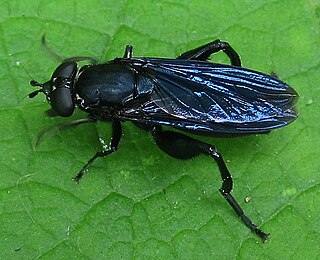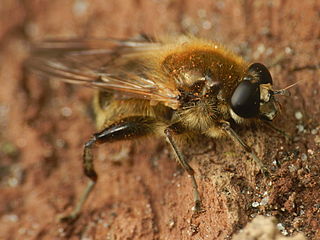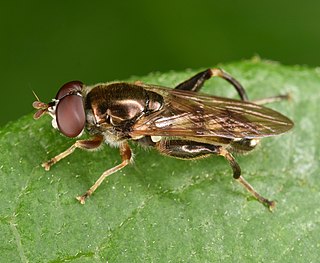
Xylota is a Holarctic genus of hoverflies similar in structure to the related genera Chalcosyrphus and Brachypalpoides. As the larvae are saprophytic they're usually found in rotting wood. The adult flies are generally associated with woodland and woodland edges and can often be seen running over the upper sides of leaves. Unlike other syrphids the adults of many species rarely visit flowers preferring instead to gather pollen from leaf surfaces. There are over 100 described species of which 12 can be found in Europe. Seven species have been recorded in Britain. Identification of species has been difficult and identifiction by photographs is risky.

Criorhina is a genus of hoverflies. Medium to large sized species, black or greenish black, with or without light ground markings mimicking bumblebees. The head is much flattened and broader than the thorax. The antennae are situated upon a prominent conical frontal process, The face is moderately produced below the eyes, downward or forward, in profile. The eyes are bare. The abdomen is elliptical or very short oval. Larvae found in rot holes or decaying hardwoods

Blera is primarily a North American genus, though there are 3 species from Europe. The genus is characterized by the following characters:

Chalcosyrphus is a genus of hoverflies in the subfamily Eristalinae. Many species exhibit some degree of mimicry of various sawflies and other hymenopterans and are often brightly coloured or metallic in hue. The adults are similar in structure and behavior to the related genus Xylota but differ in larval morphology. They can be found throughout Europe, Asia, and North America and seem to prefer damper, boggy habitats. The larvae are saproxylic feeders in rotten wood in these habitats.

Brachypalpus is a genus of hoverflies, from the family Syrphidae, in the order Diptera. The head is triangular and produced well forwards and somewhat downwards. The thorax and abdomen with pile often rather long. The hind femur is swollen and with an obtuse spur apically and ventrally. The hind trochanters of male is spurred.
The larvae are of the rat-tailed type feeding on decaying sap under tree bark. Larvae live in decaying trees and logs. Larva and pupa have been described by Malloch.

Tropidia is a genus hoverflies, from the family Syrphidae, in the order Diptera.

Henry Shimer was a naturalist and physician in Mount Carroll, Illinois. He was also a teacher at the Mount Carroll Seminary, which later became Shimer College; he was the husband of the seminary's founder, Frances Shimer.

George Duryea Hulst was an American clergyman, botanist and entomologist.

The Milesiini is a large and diverse tribe of hoverflies. They mimic wasps or hornets.

Chalcosyrphus (Xylotomima) inarmatus, the Yellow-haired Leafwalker, is an uncommon species of syrphid fly found across northern North America. Hoverflies are able to remain nearly motionless in flight. The adults are also known as flower flies for they are commonly found around and on flowers, from which they get both energy-giving nectar and protein-rich pollen.

Chrysogaster antitheus , the Short-haired Wrinkle Fly, is a fairly common species of syrphid fly found in North America. Hoverflies get their names from the ability to remain nearly motionless while in flight. The adults are also known as flower flies for they are commonly found around and on flowers, from which they get both energy-giving nectar and protein-rich pollen. The larvae in this genus are aquatic rat-tailed larvae.
Criorhina nigriventris , the Bare-cheeked Bumble Fly, is an uncommon species of syrphid fly observed across the northern United States, the Appalachian Mountains and southern Canada. Hoverflies can remain nearly motionless in flight. The adults are also known as flower flies for they are commonly found on flowers, from which they get both energy-giving nectar and protein-rich pollen. The larvae of this genus are found in decaying wood.
Criorhina tricolor is a species of hoverfly in the family Syrphidae.

Chalcosyrphus (Xylotomima) metallicus, the Yellow-legged Leafwalker, is an uncommon species of syrphid fly observed in the southeastern United States. Hoverflies are able to remain nearly motionless while in flight. The adults are also known as flower flies for they are commonly found around and on flowers, from which they get both energy-giving nectar and protein-rich pollen.
Tropidia incana is a species of hoverfly in the family Syrphidae.
Tropidia pygmaea is a species of hoverfly in the family Syrphidae.
Blera johnsoni is a species of hoverfly in the family Syrphidae.
Somula mississippiensis is a species of syrphid fly in the family Syrphidae.
Total of 245 species either found or highly expected to be found in New York.











